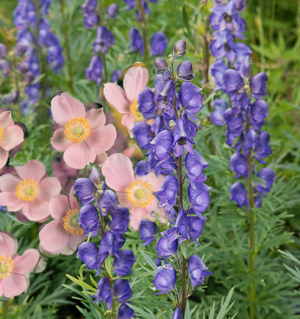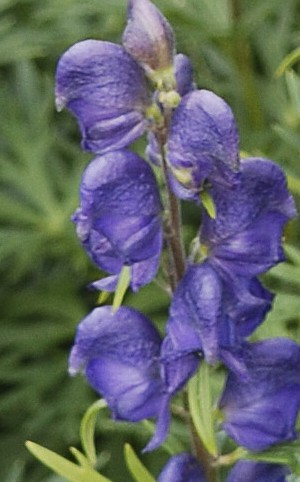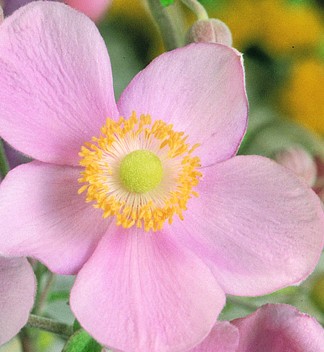 These herbaceous perennials make a long season combination with their attractive foliage and lovely flowers. The foliage of Japanese anemones appears in spring and forms an attractive dark green ground cover. In late summer tall wands of flower stems arise bearing round buds that open to single flowers with bright pink petals arranged around a mass of golden stamens with a green button of stamens in the center. Meanwhile in mid summer, monkshood produces upright spikes of intense purplish- blue to indigo flowers. An upper helmet-shaped hood covers each pea-like lower flower and creates the look of a hooded monk. Both plants grow well in light shade with adequate moisture and well-drained soil. although Japanese anemone thrives also in full sun and drier, less fertile soil.
These herbaceous perennials make a long season combination with their attractive foliage and lovely flowers. The foliage of Japanese anemones appears in spring and forms an attractive dark green ground cover. In late summer tall wands of flower stems arise bearing round buds that open to single flowers with bright pink petals arranged around a mass of golden stamens with a green button of stamens in the center. Meanwhile in mid summer, monkshood produces upright spikes of intense purplish- blue to indigo flowers. An upper helmet-shaped hood covers each pea-like lower flower and creates the look of a hooded monk. Both plants grow well in light shade with adequate moisture and well-drained soil. although Japanese anemone thrives also in full sun and drier, less fertile soil.
 Monkshood (Aconitum napellus)
Monkshood (Aconitum napellus) Originally from northern Europe, monkshood does best in a cool climate and its flowers develop their best color in the northern part of their range. The dark green leaves are deeply divided carried of flowering stems. All parts of the plant are poisonous and plants should be placed so that they are out of the range of children and pets.
Originally from northern Europe, monkshood does best in a cool climate and its flowers develop their best color in the northern part of their range. The dark green leaves are deeply divided carried of flowering stems. All parts of the plant are poisonous and plants should be placed so that they are out of the range of children and pets.
Bloom Time: Mid- to late summer
Size: 3-4’ H x 3’ W
Hardiness: Zones 3-7
 Japanese Anemone (Anemone x hybrid)’September Charm’
Japanese Anemone (Anemone x hybrid)’September Charm’ This long blooming herbaceous perennial forms attractive erect clumps and is a vigorous spreader. It has a fibrous root system and may naturalize to form large drifts. Plants should be protected from wind and more shade in hot, dry climates to prevent the foliage from burning. Japanese anemone’s are not as sensitive to heat as monkshood but cannot take the heat of the deep South.
This long blooming herbaceous perennial forms attractive erect clumps and is a vigorous spreader. It has a fibrous root system and may naturalize to form large drifts. Plants should be protected from wind and more shade in hot, dry climates to prevent the foliage from burning. Japanese anemone’s are not as sensitive to heat as monkshood but cannot take the heat of the deep South.
Bloom Time: Mid summer to fall
Size: 30” H x 36” W
Hardiness: Zones 5-8
